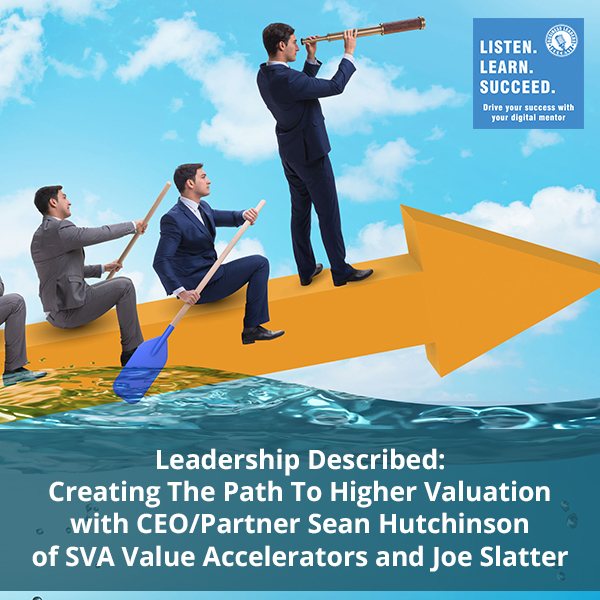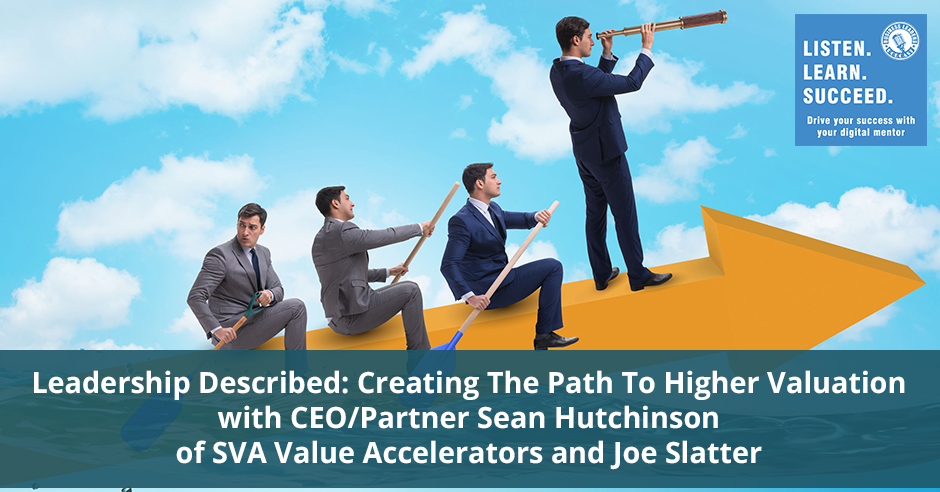Leadership Described: Creating The Path To Higher Valuation with CEO/Partner Sean Hutchinson of SVA Value Accelerators and Joe Slatter


In our value accelerator, leadership is last. That, to a lot of people, probably wouldn’t make sense, but we put it last for a reason. You will have been at whatever speed you were traveling when we started doing value acceleration. By the time you’re through sprint six, which is financial acceleration, you’re going to be moving at about 100 miles an hour much faster than you were. Your organization and your practices are going to look completely different. You’re a value-creating machine by the time you’ve gotten through those. Let Sean Hutchinson of SVA Value Accelerators and Joe Slatter, the Lead Advisor of Decision Dynamics and the SVA Leadership Accelerator, use leadership acceleration to take you from 100 miles an hour to 200 miles an hour as they talk about the path to higher valuation.
—
Leadership Described: Creating The Path To Higher Valuation with CEO/Partner Sean Hutchinson of SVA Value Accelerators and Joe Slatter
Creating The Path To Higher Valuation with CEO/Partner Sean Hutchinson and Joe Slatter
In our value accelerator, leadership is last. You will have begun with decision dynamics, making better decisions faster and figuring out what matters. You’re going to figure out how to reduce risk and keep your business less risky. You’re going to have a clear vision of your company of the future and the tools that you can use to reach your objectives. We’re going to talk about financial acceleration, productivity, sales, and marketing, then we come to leadership. Why did we put it last? That to a lot of people probably wouldn’t make sense, but we put it last for a reason. You will have been at whatever speed you were traveling when we started doing value acceleration. By the time you’re through sprint six, which is financial acceleration, you’re going to be moving at about 100 miles an hour much faster than you were and your organization and your practices are going to look completely different. You’re a value-creating machine by the time you’ve gotten through those. We’re going to use leadership acceleration to take you from 100 miles an hour to 200 miles an hour. You, as an organization, are going to be able to bear that kind of acceleration. You will not break.
We are doing a deep dive continuation with Sean Hutchinson of SVA Value Accelerators. We also have with us Joe Slatter. He’s the Lead Advisor of Decision Dynamics and the SVA Leadership Accelerator. We are going to dig into leadership acceleration.
Leadership acceleration, making leadership go faster. As Sean said, at this point, your organization has been through a transformation already. There’s a lot of good content, technique, process, and ways that you’re going to be thinking and operating in much more effective ways. I’m the business owner and I’ve got to make sense of all this and it’s still just me. The point of the transition readiness and all of this is to allow owner independence. We’ve got to get somehow figure out how to get that leadership transferred from the owner to the rest of the organization. At that point, there will have been leaders emerging. Every single one of these sprints results in leaders arriving and showing up. They’re not showing up from outside of your organization, they’re showing up from inside of your organization, which is a neat thing to watch.
I suspect the owner probably knows who some of those folks are likely going to be already. We’ve got to accelerate that process. We’re going to create a very clear focus on empowering and giving the freedom and the authority to that new leadership team. There’s an aspect of design to this. Up until this point, we’ve been focused on a lot of fundamentals and specific functional areas and specific content areas. This is about putting all of that into practice. Now we are designing the new leadership team that allows that owner to be independent and have some choices about what they do next. That’s the essence of the leadership accelerator.
That manifested itself in ways that you recognize when you see it in place. What do you typically notice when the organization has gone through the six steps and they’re now accelerating their leadership program? What do you see? What are the characteristics of that organization?
First of all, great pride at every level within the organization. People love to talk about it. They love to talk about the place that they work, the things that they’re accomplishing, and they like to say that it’s not due to them. It’s due to everyone working together, that no one had necessarily a larger impact than anyone else in the organization. Everybody was accountable. Pride is a big piece of it. Second, confidence. No matter what comes their way, they know that as a group of leaders, who have taken on the challenge of building value, that they can handle it. Those skills are present. You would also see a certain level of comfort, relief on the part of the owner that, sometimes to their dismay a little bit, they don’t have to be there for this organization to be remarkably successful.
They’ve been able to shift their perspective away from, “I’ve got to be at work every day,” to “I’ve built a legacy here that’s going to outlast me, that the people who are working here, the people that I care about the most, will be okay and thrive.” I can tell you of the owners that we work with who are thinking about transitioning ownership in their business, especially if they’re doing it to an outside party, they’re always concerned about the fate of their employees. That’s the first thing that they’ll say is, “I want to make sure that my employees are taken care of.” For them to be able to say, “We built such a business here, it’s such a legacy. I have a legacy in place. I’ve got people that are leading, I can watch it happening every day and I know as a result of this shift, they’re taking care of themselves. I don’t have to take care of them anymore. They’re taking care of themselves. They grew up. I watched them flourish.” It’s because we created an environment where that could happen.
Continuity risk is the greatest threat to value.
That’s what you see. That’s what you hear. Not an easy journey. It is hard. There’s a lot of determination that goes into it. The important thing for me, I’ve realized over the years when I’ve talked about leadership or seeing real leadership in an organization is that it’s not about picking leaders. In my mind, it’s absolutely false that people are born to be a leader. I don’t believe it. I believe that there are leaders of all types. By creating an environment where leadership can emerge and flourish, you will see lots of people become leaders. They will find their way to leadership because we are as humans ambitious and we’re also aspirational. We want to do better. Ultimately, we should want those around us to do better. We’re all part of the same group. Those are the three things that I can think of that I’ve seen. At the end of the day, it feels better.
Being the detail guy, when you get to this point, what do you recognize on the financial metrics of the company? Do you see better retention, better attraction? What do you see?
The comprehension of the right folks has gotten way up. You’ve already created a culture or improved on the culture that you already had so that the right people want to be there. The deadwood can’t survive because everyone else is holding them accountable and it’s a toxic environment for anybody who’s a throttle or a drain on the performance of the organization. Turnover goes down for the right people because we’ve already weeded out a lot of that. From the perspective of attracting talent, you end up being the magnet that gets the best people because your employees aren’t coming to work and going home. They’re going out and they’re talking to their friends. You become an employer of choice. Your team gets to be picky about who they hire because remember, this is not about you making the decisions anymore, at least not all of them. You would make the right ones, but push that decision making down. Even the recruiting, it’s not you making those decisions, it’s somebody on your team. You’ve got leaders now that can make these choices on their own. They’re better at it than you are.
CEOs or owners need to have a key role in making sure that the values that are important to the organization are sound and consistently lived within the company. They have a key role in strategy. They have to set the direction of the company. They can do it as a team certainly. At the end of the day, the owner needs to have a strong voice in that because it’s their money. They have a right to have that voice and they should exercise it. It’s fine. Everything else quite frankly shouldn’t be on their desk. That may be a hard thing for owners to hear in some cases. As I said, what you sense when a true leadership environment is there, and leaders are emerging every day with great accountability, the owner starts to say, “This feels better. This feels much less stressful. I’m seeing my money go to work in very efficient ways. I’m starting to see a return on investment that I wasn’t seeing before.”
I’ve heard often, the Millennials, those kids have a hard time finding a mentor. Do you find the incidents of leadership and mentorship increases in an organization like this?
It does. It happens at all levels. Similar to what we’re saying, the leaders not at the top anymore. The mentor is not at the top either. People start mentoring each other. In fact, in many of the organizations we’ve worked with, it almost becomes a mentor. Everyone wants to be everyone else’s mentor in their area of subject matter expertise. It doesn’t turn into chaos. It turns into a supportive, helpful group of people that if they see someone struggling, they’ll offer advice. The environment is there. That people know that advice is being given in the right way because this has become a habit. I’m remembering the podcast that we did on decision dynamics. We talked about how what happens when that owner goes away for three days. They come back. They get into their email box. They see all these emails of which only a tiny fraction was meant for them.
By the time we’re at the leadership accelerator, what’s happening is they can go away for two weeks. They come back and the only emails they have in their box are from their leadership team and their status, their updates, their performance, here’s the key results that we got that week so that you can see the pattern. It’s not decisions that need to be made. It’s not a client that had a problem that needed to be solved because those things are being handled by the rest of the organization. From an owner’s perspective and how they’re living their day-to-day, that’s a big deal. They’re doing $5,000 an hour work. This is important. What they see the most is I’m spending my time on things that build value in the organization. If I have other shareholders, I’m building value for them. If I’m the only shareholder, I’m building value for me but I built a better company that ultimately creates wealth not for me, but everybody. We like wealth in a company. We’re not going to shy away from wealth, but we need it to benefit more than the owner in order for the culture to be healthy. Wealth translates into opportunity. Opportunity is what people ultimately care about a lot. There may be some out there thinking, “This sounds a little soft.” I could see it. I get it. It’s not soft. There is a direct tie to the financial performance of the organization, the stability, the continuity of the organization.
 Leadership Acceleration: We, as humans, are ambitious and we’re also aspirational; we want to do better. Ultimately, we want those around us to do better.
Leadership Acceleration: We, as humans, are ambitious and we’re also aspirational; we want to do better. Ultimately, we want those around us to do better.
In some ways, continuity risk is the greatest threat to value. Whether you see it as volatility in a market, whether it emerges as the inability to manage the organization’s cashflow appropriately. Volatility or discontinuity in operations is a big black or red flag. You see a lot of things happen as a result of better leadership. They are very concrete. You can see them in the numbers. The other thing that we have to emphasize, that we have to plug into, is that there has been a lot of “what things do I worry about?” What keeps me up at night as a CEO or as an owner is consistently employee engagement. It comes up near the top of the list, if not number one. The owner wakes up and is saying, “Are my people with me? Do I have a vision that they believe in? Do they believe in the company? Are they going to leave? Am I going to lose my good people because they’re not locked in and I haven’t done enough for them perhaps?” That’s what we’re talking about. A lot of owners will shy away from the employee engagement and leadership question because it seems a little soft. In my opinion, that’s why we end with it in in a sense because it is the thing that puts the jet fuel in the tank. It carries the organization into the future. We’ve created a lot of momentum. The leadership will maintain that momentum and accelerate it.
For the other stakeholders, when you talk to a company or an owner that has a board that they report to, what’s the board’s reaction to this process?
To the leadership process or the whole value accelerators?
Leadership process specifically and then I guess the follow-on with the whole process.
The board certainly are looking for continuity. They do not want a situation where the business is dependent on the owner. That should be their prime directive to fix it and make sure that gets fixed. From that perspective, this is all something that the board gets very excited about . Because this is making sure that those decisions that need to be made to implement all this great stuff we’ve been talking about and carry it into the future are not dependent on the owner.
Let me add to that. I sit on a lot of boards, corporate boards for-profits and non-profits. In every case, it’s a fiduciary role. I take it very seriously. It’s not a board of advisors. We as a board hire one person and it’s the CEO. Let’s say that an owner is the only owner of a company, but they’ve made the decision to practice good governance and have a board that has independent advisors on it, which increases the value of the company. If there’s a CEO, they should be saying to the board, “I want you to evaluate my performance according to a set of criteria that we can all agree on.” One of the criteria that the board must insist on is that if something happens to the CEO or the owner, this organization will continue to run as it is expected to run at its best.
Governance is a form of leadership.
It begs a question for me as a board member, “Am I worried about something happening to the owner? Do we have a succession plan? Do we have successor leaders in the organization that could step in a moment’s notice and we won’t miss a step? We won’t miss a beat.” That’s the kind of responsibility that the board has in any organization if it’s functioning properly. Governance is a form of leadership and part of the leadership acceleration has to be to not develop individual leaders in the organization but to develop a leadership structure in a leadership environment, which extends all the way to the board of directors. If they take it seriously, they take their own leadership responsibility seriously, they’ll take this seriously.
For the reaction from the clients of the folks that go through this process, what do you hear these business owners say is the reaction of their clients? When you see a company before the process and you got the company after the process and there’s a reaction. There’s the stakeholder. There are the lending folks, the board, there are the customers and there are the employees.
To some extent, it’s the same as what the board has. If I’ve got a business that is dependent on this company to provide me with a service or a product, what I want is to know that it’s going to be there tomorrow, next year and when I need it to be. If I get a sense that the organization is dependent on Frank and I’ve known Frank for fifteen years, but Frank is getting up there. What’s going to happen when Frank is gone? I want to know that that business is going to be there to be able to keep my business thriving. The reaction to the extent that they even notice would be positive.
From the viewpoint of true leadership, the organization turns into a service organization as well. If the model is not leader-leader, it’s one leader. Someone calls and they have a problem. They keep getting passed around talking to three or four people who are all supposed to know what they’re doing, but they don’t know enough. Ultimately, they’re getting more and more frustrated because their problem is not being solved. They’re being held up by it. Everything is feeling like it’s breaking down. That’s the kind of customer relationship that nobody can afford to have. The customer can’t afford to have it either.
What happens in a leadership environment is that they make one call and the first person that they get to might be the receptionist. That problem starts getting solved right there that moment because people have access to the information that they need to begin that process. They may not be able to solve it all the way through themselves, but they at least can take responsibility for, “We have a customer. They’re in distress. Something didn’t happen.” We made a promise to the customer that for whatever reason didn’t get kept, so we’re going to go find out why. If I have to leave my station, if I have to call somebody over and say, “Here’s the situation, it’s urgent. Let’s figure this out in the next ten minutes because I want to call them back and tell them where we are.” I’m going to call them every ten minutes after that to tell them what’s going on until we have resolved that problem. That’s what customers will see and they’ll be saying, “I had three suppliers because I have to have three suppliers, but I am going to start ordering a little more from these folks over here because they have now become my preferred vendor.”
What do you hear from the lending institution that lends to these businesses? What’s their reaction to when the companies embark on this journey?
 Leadership Acceleration: One of the criteria that the board must insist on is that if something happens to the CEO or the owner, the organization will continue to run as it is expected to run at its best.
Leadership Acceleration: One of the criteria that the board must insist on is that if something happens to the CEO or the owner, the organization will continue to run as it is expected to run at its best.
Banks are interesting animals these days. The role of a banker has changed not for the better. If we think back 20 or 30 years, the role of a banker was a merchant role. They took an abiding interest in their clients. First of all, they had far fewer clients than they have to service now. The model has changed. Bankers were interested in the story. Not just the now story, but the story of where the business is heading in the future. They knew the story, they understood how they could fit into that picture and help the owner make it happen. The relationship has changed to be much more transactional and much more infrequent.
Bankers might talk to their clients once a quarter, twice a year, and only in certain situations. Good bankers who are able to or empowered by their institutions are themselves interested in creating that old kind of relationship. They are asking questions about continuity and succession and owner independence because it’s part of the credit risk. We’re now seeing, interestingly enough, credit officers asking their relationship managers and commercial side of the bank to check into what the plan is for Baby Boomer business owners’ transition or if not transition, do they have management succession in place? Where are they headed with the ownership? From the credit officer standpoint, everybody may be paying their bills on time. From the traditional credit risk perspective, everything looks pretty good.
The regulators are pretty happy, but now the regulators are starting to say to their credit officers, “We think there’s another layer of risk here. All these Baby Boomers are starting to move towards a time when they need to make some decisions. Either voluntarily or involuntarily it will be imposed on them at the time of death. They’re going to transition ownership in these businesses and we like to know something about the next generation. If you have an organization that has strong, very deeply rooted leadership in the organization, credit officers are going to be a whole lot less nervous. The bank is going to be a whole lot more willing to provide capital cheaply to their client when they need it because they believe in the story. They believe that the investments have been made. They understand that they’re dealing with a very smart, capable organization at all levels. As far as I’m concerned, banks aren’t interested enough yet in this particular area. I talk to a lot of bankers and I know they’re getting a lot more attuned, not to what’s going to happen with the transition, but operationally how sound is this organization. When you walked into a true leadership organization, you feel it right away. No question.
You see a lot of things happen as a result of better leadership.
Looking at two businesses, let’s say that they’re virtually identical except one has gone through the process and has all of the seven value acceleration steps in place and it’s cranking. The other one is still got the one guy. What would you say if you can characterize the multiple difference?
There are three ways to increase the value of the business: increase your earnings, which is typically what owners and their teams will focus on the majority of the time. That does drive value in a business; that margin management is important. The more margin you can drive, especially at the gross profit level, the more interested we are in the business from a value creation standpoint. Reducing risk is a big category. It’s the thing that drives the increase in multiples for a lot of different reasons. The top two risks in an organization that drive multiples down or make the business entirely un-transferable, in other words, having zero value or asset value, not even book value, just asset value, liquidation asset value.
In those cases, the top two risks are customer concentration, which could be industry concentration. It could be a customer. It could be market, whatever, but any kind of concentration is going to concern us. Basically, having too many eggs in one basket. The second big risk is owner reliance. Reliance, when it’s present, is a real value killer. Not having reliance is, in fact, going to increase the multiple that could be applied to EBITDA or revenue. There are good reasons to care about it. As to the difference between an organization that has a high level of reliance on an owner versus one that has distributed leadership and a culture that continues to develop it and get better at it, I would argue that, in some cases, regardless of what the balance sheet and the income statement say, the value of the highly owner-reliant business might be zero.
 Leadership Acceleration: The owner-independent business that has the true leadership culture is worth infinitely more.
Leadership Acceleration: The owner-independent business that has the true leadership culture is worth infinitely more.
The owner independent business that has the true leadership culture is worth infinitely more. This issue if of leadership, you can talk conceptually about leadership all day long. It’s fun and it’s right. It’s an important concept. If you tie it to the risk of owner reliance, these are the two ends of the spectrum that we’re talking about. True leadership culture, developing it every day, emergent leaders showing up to the party and making a difference, making the right decisions faster, better. You’ve got owner reliant businesses, which typically have leadership that has withered on the vine. Good people are leaving all the time. They can’t seem to attract quality people into the company. They’re on that little hamster wheel. It’s a death spiral. Nobody else can step up to that plate because they’re all gone, then the differences are infinite.
With infinite value proposition, how do people find you on social media?
LinkedIn is a great way to find us. We have a company page, SVA Value Accelerators. Look it up. You can do a search for it. My LinkedIn page is LinkedIn.com/in/seanphutchinson. For Joe, it is LinkedIn.com/in/slatter. Our website is BuildValueToday.com and all the contact information that you need for all of our advisors and partner teams are there.
The only mistake the readers can make is if they have a question not reaching out. You guys have a solution or something exciting showing up in the first quarter of ‘19.
We are establishing an online learning platform. In there will be online learning opportunities, both in the form of a la carte online learning as well as curriculum courses. It’s available to everybody. If you’re in that explorer category where you’re trying to get familiar with some of the concepts that we’ve talked about throughout this series, then you can do it there. We’re also launching mastermind groups, which are groups of eight to twelve owners, noncompeting businesses, which will support each other through one-year program. Peer-driven, peer-supported, expert-facilitated, which covers and tracks the value accelerator sprint by sprint. It’s a lighter version of it. Either of those two ways is a great way to wade in before you might want to make a larger commitment to the full value accelerator. The first quarter of 2019.
This has been fascinating. I appreciate you taking the time. This is the last of the modules. Thanks so much.
Links Mentioned:
- http://BuildValueToday.com/
- ReadyForNextAcademy.com
- SVA Value Accelerators
- Decision Dynamics
- SVA Value Accelerators on LinkedIn
- LinkedIn.com/in/seanphutchinson
- LinkedIn.com/in/slatter
- ReadyForNextAcademy.com
About Joe Slatter
 I am the creator of the Better Practice methodology, which is the underlying framework for SVA’s Decision Dynamics sprint and Leadership Accelerator. My mission is to help individuals, organizations and communities accelerate toward better.
I am the creator of the Better Practice methodology, which is the underlying framework for SVA’s Decision Dynamics sprint and Leadership Accelerator. My mission is to help individuals, organizations and communities accelerate toward better.
I have lived in six countries and worked extensively with global, cross-functional and highly distributed teams. I created Better Practice with the belief that teams, organizations and communities can improve their performance by establishing a common sense and listening to each other.
My life’s work is the application of design thinking to how we work together. How can we figure out what matters together, make better decisions faster and act together with grace and accountability? I call it metacollaboration.
About Sean Hutchinson
 Over my 25+ years in business, the best lessons I’ve learned have been from business owners who have generously shared their stories of success and struggle and allowed me to offer insights and guidance based on my experiences.
Over my 25+ years in business, the best lessons I’ve learned have been from business owners who have generously shared their stories of success and struggle and allowed me to offer insights and guidance based on my experiences.
We share a bond. I’ve founded five companies, all of them with partners, some more successful than others. I’ve led a fast-growing global company as a very green, but hard-working and quick-learning, 34-year-old who every day had to make big decisions with big implications. It became the largest firm of its kind in the world. And, maybe most importantly, in this case, I’m the 3rd Generation heir to my family’s 62-year-old custom millwork manufacturing business. I’ve sat in your chair many times and I love being an entrepreneur.
As one of the three founders of SVA, my role is once again to fulfill the responsibilities of the Chief Executive Officer. I focus on strategy and growth – in other words, our Company of the Future. And that’s where I help our clients too – working with owners and their leadership teams to imagine what could be, can be, and will be their Company of the Future. I see my work as transformational, not just transactional. It’s all about getting you “Ready for Next.”
Love the show? Subscribe, rate, review, and share!
Join the Business Leaders Podcast Community today:
- businessleaderspodcast.com
- Business Leaders Facebook
- Business Leaders Twitter
- Business Leader LinkedIn
- Business Leaders YouTube
The post Leadership Described: Creating The Path To Higher Valuation with CEO/Partner Sean Hutchinson of SVA Value Accelerators and Joe Slatter appeared first on My podcast website.